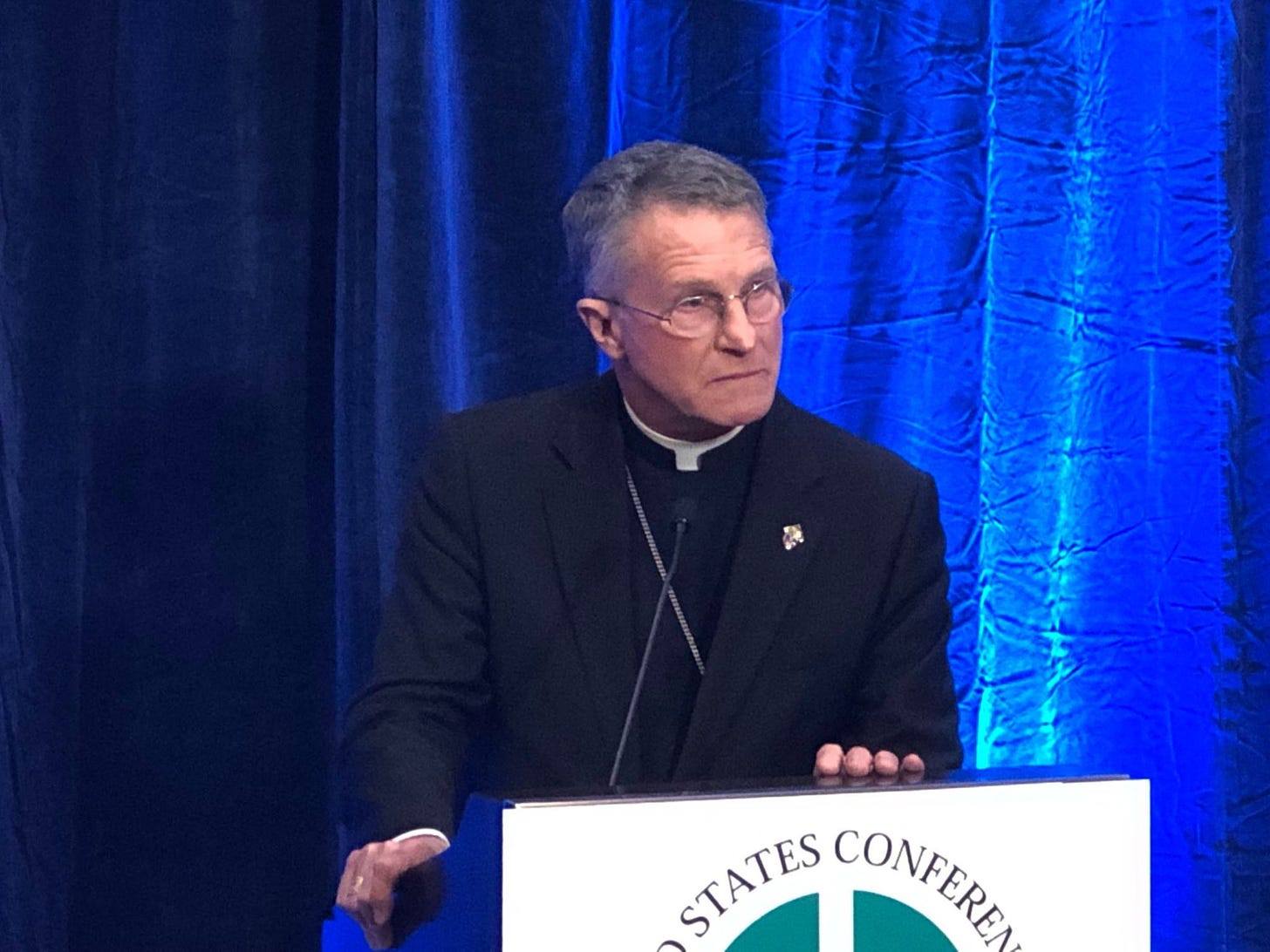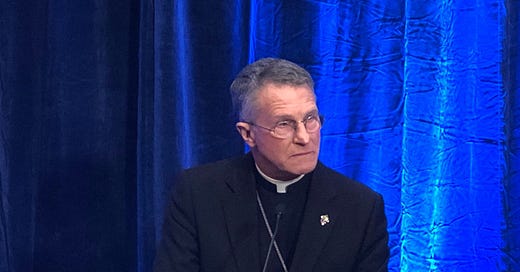
Broglio: conservative, continuity, or compromise?
The bishops took three rounds of voting to elect a new USCCB president. But does Archbishop Broglio have stronger hand than you might think?

The U.S. bishops’ elected a new president and vice president on Tuesday afternoon, returning Archbishops Timothy Broglio and William Lori after third round runoff elections for both positions.
The extended voting sessions needed to return the archbishops as president and vice president painted a picture of a conference without a clear consensus, and suggest the bishops may already be looking ahead to their next vote in three years.
But it is not clear that an expected turnover among the American episcopate in the coming years will produce a new majority for a different kind of leadership. In the meantime, the lack of consensus among the bishops could shift how the Broglio presidency is seen, both within the Church in the U.S. and in Rome.
—
Archbishop Broglio was the consensus choice to win election among virtually all conference watchers before the vote Tuesday, with many - including The Pillar’s JD Flynn - expecting him to record the “50%- plus-one” needed for election on the first ballot, even with a crowded field of 10 candidates.
As it happened, Broglio got in the first poll almost exactly twice as many votes as his nearest rivals, but not nearly enough to win outright. Instead, both Lori and Archbishop Paul Etienne of Seattle both recorded strong results through two rounds of voting, with other candidates continuing to attract votes even as Broglio’s lead grew.
In the run-up to the election, Broglio was widely tagged as a “continuity candidate,” serving as conference secretary and having been runner-up in the vice-presidential election three years ago.
He is also usually framed as “conservative” bishop, at least relative to some other members of the conference.
Under outgoing president Archbishop Jose Gomez, the USCCB’s leadership has often been seen as at odds with the Vatican, striking a tone and approach often different from the pope’s on ecclesiastical and political issues. At the same time, senior bishops like Chicago’s Cardinal Blase Cupich emerged as a kind of alternative line of communication with the Vatican and interpreter of the American ecclesiastical scene.
But if Broglio has been seen fit to lend his support to the calls for clear presentation of Church teaching on politically hot topics, like last year’s debate on Eucharistic coherence, he also has years of experience working in the Vatican’s diplomatic service and Secretariat of State.
Challenged about the significance of his election in his first press conference as president-elect on Tuesday, Broglio batted back the suggestion that it represented some kind of alternative agenda, or any kind of “distance” between him or the conference and Pope Francis.
If Broglio can call on his past experiences as a Vatican diplomat, he could prove an effective communicator for the U.S. bishops in their dealings with the Holy See.
At the same time, the circumstances of Broglio’s election mean his mandate is closer to that of a “compromise” rather than “continuity” president. The extent to which he will have to represent a diversity of voices within the conference, instead of a super-majority block, will mean he can credibly claim to speak for all sides of the American hierarchy, rather than being the tribune of one or other faction.
📰
—
If Broglio has often been reflexively labeled “conservative” by commentators and Church-watchers, Archbishop Etienne’s candidacy was widely understood to be a kind of standard bearer for the more progressive wing of the bishops’ conference, often associated with Cardinals Blase Cupich and Robert McElroy.
The 30 votes the Seattle archbishop attracted in the first round might be a baseline of support that group can muster, while Lori is widely seen as an established figure among the US bishops, collegially minded and a veteran committee leader at the conference.
But Lori’s candidacy, even before the conference began, was also seen by some as likely to attract tactical support from bishops close to the Cupich-McElroy wing, especially in the later rounds, who might favor another open election in three years.
Lori’s election as vice president means that, for the second time in a row, the U.S. bishops have chosen a vice president who will be too old to be voted in as president at the next election, likely ending what was the settled tradition among the U.S. bishops of electing the conference VP to succeed to the presidency as a matter of course, clearing the way for another open field in three years.
Between now and then, the conference membership will likely see a generational change: 10 diocesan bishops in the United States are serving past the nominal retirement age of 75, and more than double that number will have to offer their resignations before the bishops meet in 2025 to vote for Broglio and Lori’s successors, plus a dozen or so auxiliary bishops.
But the speed at which the conference membership will turn over, and the kind of change that turnover could bring with it, is by no means clear.
Despite the number of bishops past the age of retirement, American episcopal appointments have ground nearly to a halt, with few names being cleared and announced by Rome for U.S. dioceses in recent months.
The lack of new episcopal blood comes even though both Cardinal Blase Cupich and Cardinal Joseph Tobin serve as members of the Dicastery for Bishops, the Vatican department charged with recommending candidates to the pope. The received wisdom among the U.S. bishops and Church watchers is that through their influence over episcopal appointments, the American cardinals will gradually remake the conference.
But officials close to the appointment process in the dicastery report consistently a number of difficulties in naming new American bishops.
Most often, they cite the unwillingness of many priests to accept episcopal appointment when asked, sometimes putting the percentage of “nay” as high as 30%, and strict criteria from the dicastery’s American members on the kind of priests who can be considered in the first place, resulting in a tiny pool from which to draw nominations.
In recent months, those officials have also reported increasing dissatisfaction in Rome with the quality of some of the candidates which can be found under those conditions, further stalling the naming of new bishops.
As more American bishops move closer to the age of 80 than 75, it’s clear that something will have to give in the appointment process; the criteria for consideration will have to get looser if the pool of potential candidates is to get deeper.
As it does, it may see a new generation of bishops come into the USCCB, but one not necessarily well suited either to the “conservative” or “progressive” labels which have defined the conference’s elections for the last few years.




